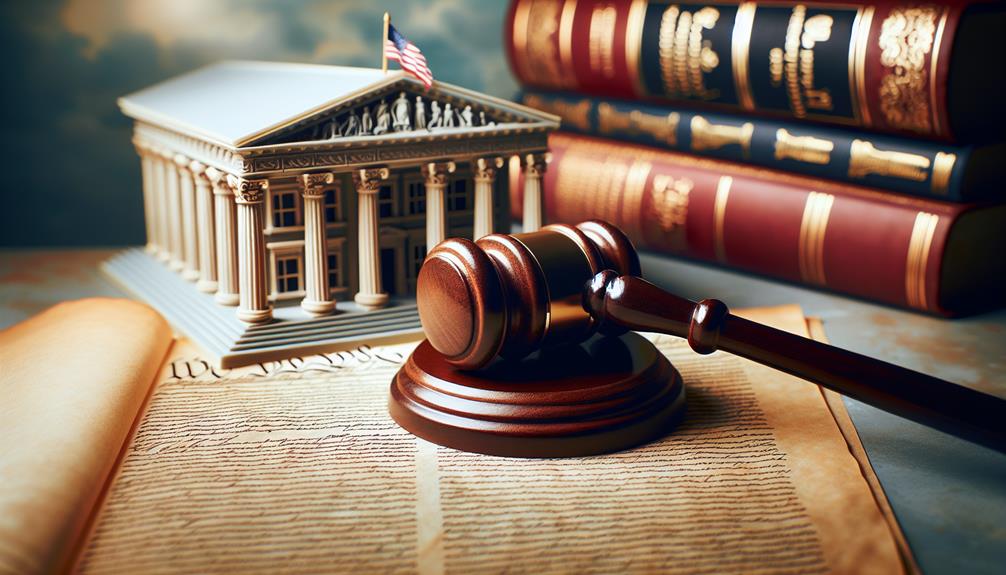While you might think that the language of Article 2 is too complex to grasp, breaking it down can clarify the powers and limitations placed on the U.S. President. As you explore this critical piece of the Constitution, you’ll see how it not only outlines the role of the Commander in Chief but also sets the stage for ongoing debates about executive power. What’s intriguing is how these powers are checked by other branches of government, a dynamic that raises questions about contemporary issues in presidential authority. Are these checks sufficient, or is there a need for more stringent controls? Let’s examine this further.
Overview of Article 2 of the Constitution
As you explore Article 2 of the Constitution, you’ll find it meticulously outlines the extent of Presidential powers. This segment is essential for understanding how the President’s authority is framed and its implications on the executive branch‘s role in governance.
Each clause and section not only defines the scope of presidential duties but also emphasizes the significant balance required between power and accountability.
Explanation of Article 2 Presidential Powers
Article 2 of the Constitution vests significant powers in the President, defining the scope and limitations of the executive branch’s authority. As you explore further into its provisions, you’ll discover that it outlines the President’s core roles including being the Commander in Chief of the armed forces, granting the ability to lead the military yet requiring Congressional approval to declare war. This balance is critical in maintaining a check on executive power.
You’ll also find that Article 2 grants the President the power to appoint federal officials, including judges to the Supreme Court, with the advice and consent of the Senate. This ensures that while the President has considerable influence over appointments, it isn’t unilateral. The requirement for Senate approval is a fundamental check on this power.
Moreover, Article 2 empowers the President to negotiate treaties, again contingent on the Senate’s ratification. This treaty-making process exemplifies the collaborative nature of U.S. governance, where the executive and legislative branches must cooperate to shape foreign policy.
Understanding these powers, you become aware of the President’s ability to influence legislation through the veto power. While the President can veto legislative acts, Congress can override this veto with a two-thirds majority, thus providing another essential check on presidential power.
Significance of Article 2 in Presidential Authority
As you examine the historical context and evolution of Article 2, you’ll find that its provisions critically shape the scope of presidential powers.
The framers designed Article 2 to balance robust executive authority with necessary constraints, ensuring a dynamic yet controlled leadership framework.
Analyzing these transformations over time reveals how shifts in political philosophy and practical governance needs have influenced the current interpretation and implementation of presidential powers.
Historical Context and Evolution of Article 2 Powers
Understanding the powers granted by Article 2 of the Constitution reveals how presidential authority has evolved since the founding of the United States. Initially, these powers were broadly defined, leading to varied interpretations over time.
As you explore further, you’ll see shifts influenced by historical events and Supreme Court rulings, which have clarified, expanded, or restrained presidential powers to shape the role’s current dynamic.
Specific Presidential Powers Defined in Article 2
You’ll find that Article 2 grants the President significant military authority by defining the role of Commander-in-Chief. This designation empowers the President to oversee and direct military operations, a power that’s critical in wartime scenarios.
Additionally, the pardoning power allows the President to forgive or mitigate federal crimes, showcasing a unique check within the U.S. justice system.
Commander-in-Chief Role
As the Commander-in-Chief, you must understand that the President’s military authority, as defined in Article 2 of the Constitution, is both robust and circumscribed. You’re granted the power to direct military operations and make key defense decisions, yet this power isn’t absolute; it’s balanced by Congress’s authority to declare war and control military funding.
This delineation guarantees that military power remains under civilian oversight, preventing any overreach or misuse of power.
Military Authority and Limits
Article 2 of the Constitution clearly delineates the President’s role as Commander-in-Chief, granting him direct and substantial authority over the military. However, this power isn’t absolute.
You must recognize that Congress holds the keys to declaring war and funding military operations, effectively setting boundaries on presidential military control. These checks guarantee that military power is balanced, preventing any overreach by the executive branch.
Pardoning Power
Under Article 2 of the Constitution, the President possesses the sole authority to grant pardons for federal offenses, excluding cases of impeachment. This power places a significant tool at your disposal, allowing you to mitigate or modify the consequences of criminal convictions. It’s important to understand that this power is absolute regarding federal crimes, meaning no other branch of government can override your decision to pardon.
You might wonder about the scope and limits of this power. While broad, it doesn’t extend to state offenses, as those fall under state jurisdictions and are beyond presidential influence. Additionally, the exclusion of impeachment cases ensures a balance, preventing you from using the pardon to disrupt the legislative branch’s role in holding officials, including yourself, accountable.
This power’s origin traces back to the English monarchy, where it was used as a means of showing mercy and fostering forgiveness. In the U.S., it reflects a similar intent but is framed within a constitutional context that emphasizes both mercy and checks and balances.
Checks and Balances on Presidential Powers
You must recognize that while Article 2 vests significant powers in the presidency, it also outlines mechanisms for checks and balances. Congressional oversight and the power of impeachment allow Congress to monitor and, if necessary, remove a president who misuses power or engages in misconduct.
Additionally, judicial review of presidential actions guarantees that the executive branch adheres to the Constitution, providing a legal check on presidential authority.
Congressional Oversight and Impeachment
Congress wields significant power to oversee and, if necessary, impeach the President, guaranteeing a rigorous balance of authority within the federal government. This oversight function is crucial as it keeps the executive branch from overreaching its constitutional boundaries.
You’ll find that through various mechanisms, including hearings, investigations, and subpoenas, Congress can scrutinize presidential actions and policies. This oversight isn’t just about catching wrongdoing; it’s about maintaining transparency and accountability in the Presidency.
When it comes to impeachment, it’s a tool Congress can use if the President commits ‘Treason, Bribery, or other high Crimes and Misdemeanors,’ as specified in the Constitution. This process begins in the House of Representatives, which holds the power to impeach the President by a majority vote. Following impeachment, the Senate conducts a trial. A two-thirds majority in the Senate is required to convict and remove the President from office.
You should understand that these powers aren’t wielded lightly. Historical usage shows that impeachment is a rare and severe action, reflecting its profound implications on governance and public trust.
Therefore, these mechanisms ensure the President remains a servant, not a ruler, adhering strictly to the structured limits of authority defined by the Constitution.
Judicial Review of Presidential Actions
While Congressional oversight serves to monitor and potentially impeach the President, the judiciary also plays a pivotal role in reviewing the constitutionality of presidential actions. As you explore further into Article 2, you’ll recognize that the Supreme Court and lower federal courts can exert significant checks on presidential power through the mechanism of judicial review.
This judicial review process allows the courts to assess whether executive actions adhere to the Constitution. It’s an essential function, particularly when you consider the separation of powers doctrine embedded in the U.S. governmental structure.
For instance, if the President issues an executive order that oversteps legal boundaries, affected parties can challenge this order in court. The judiciary then evaluates whether the order aligns with constitutional mandates.
The courts’ decisions can limit or even nullify presidential directives, ensuring that no branch of government, including the presidency, wields unchecked power. This balance is important for maintaining the democratic structure of the nation.
Additionally, these judicial checks aren’t merely theoretical; historical precedences like the ruling in United States v. Nixon (1974) underscore the judiciary’s role in curbing excessive presidential authority. Hence, understanding judicial review is essential for grasping the full scope of checks and balances designed to prevent any abuse of presidential power.
Controversies and Interpretations of Article 2 Powers
As you explore the complexities of Article 2, consider how the expansion of executive privilege has sparked significant legal and political debate.
You’ll find that interpretations of presidential power, especially under the War Powers Resolution, continue to challenge conventional boundaries, raising pivotal questions about constitutional intent and modern governance.
These controversies highlight the ongoing struggle to balance executive authority with the need for checks and balances.
Expansion of Executive Privilege
The expansion of executive privilege under Article 2 has sparked significant debate, centering on the boundaries of presidential power and its implications for checks and balances. As presidents have interpreted these powers expansively, tensions have risen regarding the transparency and accountability of the executive branch.
Historically, executive privilege was intended to protect sensitive information that, if released, might compromise national interests. However, the scope of this privilege has broadened controversially. For instance, it’s been used to withhold information from Congress or to avoid subpoenas, asserting a need to protect internal deliberations within the executive branch. This move has often been criticized as a veil for avoiding scrutiny.
Courts have intermittently weighed in on this issue. The U.S. Supreme Court, in landmark cases, has recognized executive privilege but also set limits, emphasizing that it isn’t absolute. The balance attempts to make sure that the president can perform duties effectively without encroaching on the legislative and judicial branches’ powers.
Understanding these dynamics is vital. It isn’t just about the legal battles; it’s about grasping how these decisions shape the foundational principles of American governance, potentially altering the power dynamics among the branches of government.
Debates on War Powers Resolution
You must understand that the War Powers Resolution was enacted to check the President’s authority, addressing Article 2’s ambiguity regarding war declaration powers.
This legislation mandates that you, as President, must consult Congress before committing U.S. forces to hostilities.
However, controversies persist over its effectiveness and constitutionality, influencing how modern presidents exercise military power.
Implications on Modern Presidential Authority
Understanding the scope and limitations of Article 2’s powers, particularly in context of the War Power Resolution, reveals complex debates over presidential authority in military engagements.
You’ll find that presidents often navigate a fine line between constitutional mandate and congressional oversight.
This balance is critical, especially as global conflicts evolve and the demands on American military power increase, testing the boundaries of executive discretion.




